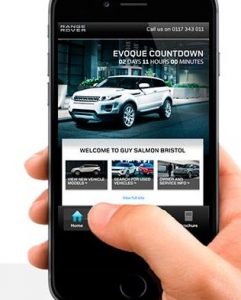The Evolution of Mobile Websites
2017 has become the year most E-commerce websites will really be mobile websites. To avoid being left behind in the ever more aggressive competition, one will need to be aware of the latest trends in e-commerce and the benefit from these trends. These megatrends are universal, global, have huge implications, and seem to be around for the long run.
When site design trends for a particular year, like 2017 are discussed, one is really trying to take a look at the current state of website design and predict what aspects of the current state will continue to grow significantly.
The most significant change, then, could be in how designers reflect about their designs. In the past, when a site is thought about , it was imagined in its desktop form. The responsive mobile view of the site is THE CHANGE. In the year 2017, a site’s true identity seems to be its mobile form.
Web Design Is Mobile Design
 Ecommerce website design has evolved. Articles about design trends written a few years ago, might have mentioned a responsive or adaptive design. The idea then was to transform a site’s desktop design so that it could be accessed on a mobile device. Over time, some writers and designers even touted mobile first design. Sometimes designers put mobile CSS statements higher in the document, but they probably still think of the site as its desktop version.
Ecommerce website design has evolved. Articles about design trends written a few years ago, might have mentioned a responsive or adaptive design. The idea then was to transform a site’s desktop design so that it could be accessed on a mobile device. Over time, some writers and designers even touted mobile first design. Sometimes designers put mobile CSS statements higher in the document, but they probably still think of the site as its desktop version.
2017 has turned that idea on its head. Many online stores visitors and customers use mobile devices to shop. This means that websites will be designed for mobile and made responsive or adaptive for larger screens. Designers will create sites first in its mobile form.
Here are a few possible examples of this trend played out on mobile:
Accelerated Mobile Pages
It makes up 7% of traffic to US publishers – Adobe Analytics (2017)
Google’s Accelerated Mobile Pages (or AMPs), introduced in October 2015, are intended to deliver lightning-fast web browsing on mobile phones. Google is able to load content from search results with amazing speed by serving pages through their own servers. For better clarification, AMP pages are something one creates one’s self. Basically, an alternate or personalized version of web pages that conform to the AMP Project specifications.
What’s the return?
Well, for the most part AMPs have shown promise – the amount of AMPs on the web have grown by over 400%, and the Washington Post seems to have increased return visitors by 23% thanks to AMPs.
BUT, there’s always another side to the story. Multiple publishers said an AMP page view currently generates around half as much revenue as a page view on their full mobile websites as reported by the Wall Street Journal. Who knows if this will affect the use of AMP as the AMP Project is still in its infancy, only time will tell.
Mobile menus on the Left
Hamburger menus are moving to the left. This will be a small and subtle change: If a web designer used the Bootstrap framework and followed the Bootstrap 3 Navbar example, that design tended to end up with a hamburger menu on the right side of the navigation.
Lots of websites followed this pattern. But Google, some leading sites and mobile apps have started placing their hamburger menus on the left so that those menus are among the first things a user finds on the page, even when he is using an assistive device like a screen reader. Google began placing hamburger menus on the left of the interface for many of its applications.
Cinemagraphs, or the Return of the GIF
T he animated Graphic Interchange Format, GIF image may be making something of a comeback in 2017, although as a cinemagraph. Really a cinemagraph is a still picture, a photograph to which a small, repeating animation has been added. The result is a sort of mini-video experience more subtle than the animations on Ling’s Cars, but still as eye catching.
he animated Graphic Interchange Format, GIF image may be making something of a comeback in 2017, although as a cinemagraph. Really a cinemagraph is a still picture, a photograph to which a small, repeating animation has been added. The result is a sort of mini-video experience more subtle than the animations on Ling’s Cars, but still as eye catching.
Cinemagraphs may appear as background images, category headers, home page banners, and even product images. Time will tell if cinemagraphs boost engagement and conversions or if they are just a fad.
There abound other ecommerce design trends but these two, however, deserved a mention.
First, advanced adaptation or improved responsiveness. Now sites adapt to screen size or device. In the nearest future sites could adapt to specific users, changing layout based on age, visual acuity, or even if they are left or right handed.
Second, is an explosion of color in web design in 2017. Minimalism and conservatism has dominated site design for a few years before . As a reaction, we now see lots of bright colors and flashes.
Mobile Security
While businesses continue to invest in mobile apps and spend heavily on mobile marketing, mobile security is one field that shouldn’t be ignored. Business apps are not as secure as some of the large apps like Evernote. This is where businesses and marketers spend heavily in 2017 and beyond.
Just like Secure Sockets Layer (SSL) certificates, sometimes called digital certificates, are now a must-have part of any website, something similar will soon happen for business apps.
Big Data
Big data is said to be the key to mobile marketing as mobile marketing is shaped by the growth in big data as stated by Business Insider. There will be a statistically significant increase in the number of big data marketing apps especially for mobile marketing that will help brands get predictive analytics and customer insights . Smart Insights pointed this as one of the leading digital marketing trends for 2017.
How a business deals with big data and how it uses it to get better with mobile marketing is the real question.
Engage with mobile customers via messaging
Interest in mobile messaging apps, like WhatsApp, Snapchat, Facebook Messenger and Apple’s Messenger, remains strong despite the prevalence of mobile phone fatigue. Falling data prices, cheaper devices, and improved features are helping propel the growth of messaging apps which have millions of monthly active users Business Insider reported.








ClgfaUYwQR
rvusmGeEotUjI
It is appropriate time to make some plans for the future
and it’s time to be happy. I’ve learn this publish and if I
may just I desire to counsel you few interesting issues
or advice. Perhaps you can write subsequent articles relating to this article.
I desire to read more issues approximately it!
cialis daily benefits goodrx tadalafil prescription tadalafil by cipla
dosage of tadalafil tadalafil ema cialis uses
tadalafil preis österreich cialis daily heallthllines tadalafil generika kaufen
viagra connect alternatives viagra price reduction sildenafil gewöhnung
cialis metoprolol interaction tadalafil cost goodrx tadalafil powder bulk
pfizer viagra cost hmo viagra cost viagra size pills
tadalafil 20mg pricing cialis supplement cialis c20 dosage
viagra cena sildenafil vs kamagra fastest acting viagra
cialis canada paypal cialis miglior prezzo tadalafil cipla
sildenafil vs viagra viagra boys merch is sildenafil prescription
viagra contraindications bnf viagra tabs sizes viagra trial offer
dypREMDZcLPImO
cialis split pill goodrx cialis reddit woman and cialis
va prescribed cialis tadalafil female effects cialis price
imdur and viagra sildenafil in stroke sildenafil citrate dosage
cheapest tadalafil 5mg unicure remedies tadalafil cialis savings plan
sildenafil pills canada sildenafil citrate photos viagra causes headaches
soft tabs cialis cialis tadalafil nedir cialis like viagra
sildenafil maker sildenafil citrate wikipedia otc viagra cvs
about female viagra expired viagra safe viagra blue dress
levitra wiki pl levitra youtube vardenafil 20mg tablets
viagra price germany viagra prix maroc sildenafil citrate revatio
sildenafil pill number sildenafil canada eviaged viagra weight lifting
sildenafil pill markings viagra single packs sildenafil canada eviaged
levitra nebenwirkungen preco levitra odt levitra max dosage
viagra goes generic sildenafil citrate einnahme sildenafil citrate avis
levitra tablets preludemd levitra reactions levitra od
viagra hypertension sildenafil teva online viagra flüssig
viagra trial free viagra for men viagra wirkungsweise
levitra generic field gia tien levitra levitra odt spc
enhancing viagra grapefruit juice viagra pediatric dosage sildenafil
test viagra sildenafil recommended dosage viagra generic cost
levitra coupons printable levitra blog levitra tablete forum
sildenafil brand names viagra coração viagra plus review
blue pill viagra fda warning sildenafil viagra and aspirin
types of cialis cialis online sicuro cialis cialismalew com
levitra lisinopril interaction vardenafil mepha bayer levitra erfahrungen
goodrx prices tadalafil tadalafil 20mg canada hims cialis prices
viagra question sheet viagra cost costco sildenafil for heart
viagra retail cost sildenafil prescription veterans administration viagra
viagra gas stations acheter du sildenafil sildenafil citrate ajanta
levitra china levitra kupnja levitra price
food containing sildenafil viagra non generic sildenafil generico bula
tadalafil generique forum cialis and bph tadalafil prix maroc
viagra wirkung frau sildenafil citrate otc viagra coffee
levitra ansiedad test levitra generika levitra belgique